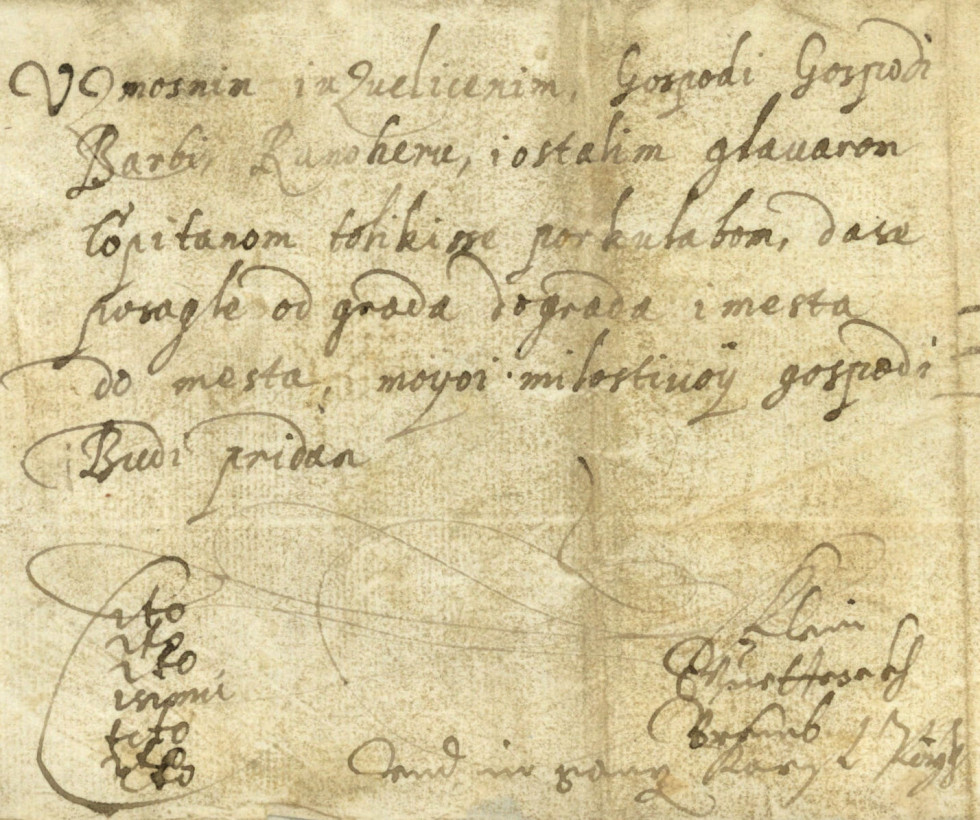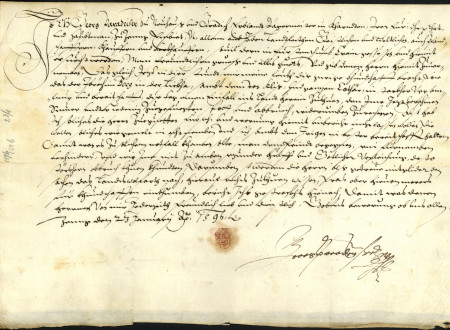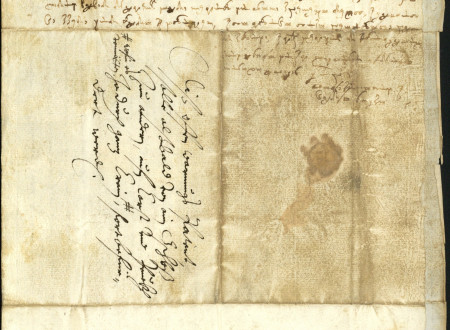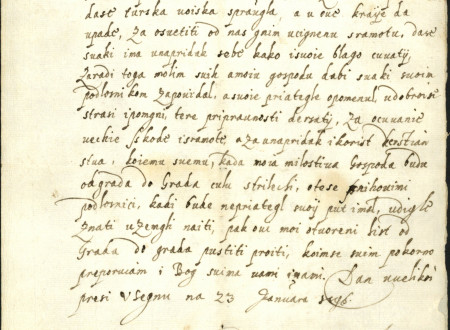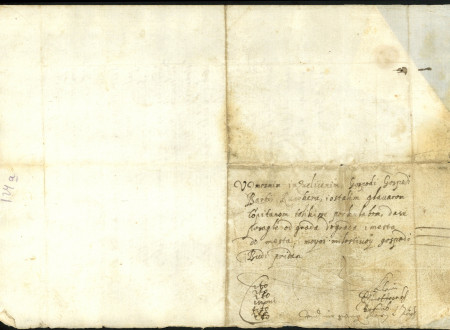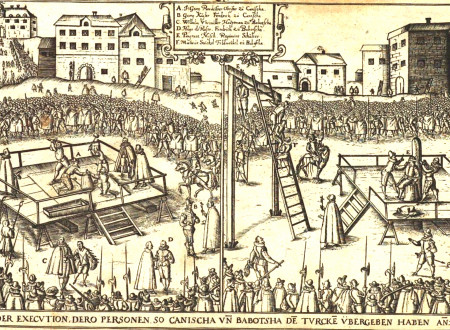Good or wicked?
Turkish Alerts by Georg Paradeiser and his Inglorious Ending
Incursions of Ottoman Turks were one of the biggest hardships that the 15th and 16th century inhabitants of Slovene territory had to endure. The most destructive attacks were launched between 1469 and 1483. By 1520s and 1530s, attacks were frequent but less extensive and less violent, until they eventually ceased and occurred only in Carniola. The last attack on Carniola took place in the winter of 1559, but a potential danger of oncoming incursions was still looming large in people's minds, as is well evidenced from a number of reports about the gathering of Turkish army troops and about what actions to take against any future attacks. The danger was all the more serious, since by the end of the 16th century, Turkish and Carniolan borders were merely 15 kilometres apart from each other.
Successful defence against the Turks depended on well-developed intelligence and signal service. In addition to “global” intelligence, coming from Venice and Dubrovnik, special intelligence along the Croatian-Turkish border was needed as well to protect the nearby territories that were in immediate danger of being attacked. News about the approaching Turks, which castellans and military commanders on the border received from their spies and prisoners, was written down and sent to Carniola through messengers by using a special postal network. Such secret reports were called Turkish alerts (Türkenkundschaft). They were written in a particular form and could even at first glance be distinguished from any regular letter. They usually provided information about the amassing of Turkish army, the number of Turkish soldiers and their probable route of attack, all the while urging population to be prepared. Turkish alerts were written mostly in German, some of them also in Italian and Croatian language, and sometimes in the Glagolitic script.
Interesting examples of such Turkish alerts are alerts sent by Georg Paradeiser, Captain of Senj. At the time, Senj was one of the main pillars in the fortification system of the Military Frontier and one of the most important intelligence centres along the Croatian-Turkish border between the river Sava and the Adriatic Sea. Georg Paradeiser came from a prominent Carinthian noble family, which had several family branches and which had owned property in Carniola ever since the start of the 15th century. He is believed to have been born between 1565 and 1570, but we know nothing about his youth. He is first mentioned in 1594, when he visited Prague on behalf of the Archduke Maximilian III. That year he also got married and Emperor Rudolf II gave him a valuable wedding present, a clear indication of the recipient’s reputation. Between 1595 and 1598 he was a military commander in Senj. In the spring of 1596, during his involvement in the attempt to free the fortress of Klis near Split, he is even believed to have been taken prisoner by the Turks for a short period of time.
On January 23, 1596, Georg Paradeiser, Carinthian hereditary land hunting master and Habsburg’s captain in Senj, signed two Turkish alerts. The first one, which is more concrete as far as its content is concerned, was written and sealed by Paradeiser himself. In addition to the usual “address” on the backside of the letter, there is also a writing in Glagolitic script, probably a summary of the German message. Although more general, the second alert is also very interesting. It is written in Croatian (Kvarner Gulf) dialect and signed by Paradeiser, although it could have been written by someone else. If we transcribe it into modern script, add an occasional punctuation mark or capital letter, and logically separate or connect the words, the text would read as follows:
"Plemenitim, izbranim, kako vzmožnim i vzveličenim i svake plemenite časti i hvale dostojnim, gospodi kapitanom, glavarom i porkulabom, svim tim daje moja prepravna služba preporučena. Vazda, ne mogoh prepustiti vam moja gospodo za oznaniti, kako moji junaci, koji su na putu bili, danas doidoše, koji za istinu povidaju, da se turska vojska spravlja, a u ove kraje da upade, za osvetiti od nas njim učinjenu sramotu, da se svaki ima unapridak sebe kako i svoje blago čuvati. Zaradi toga molim svih a moju gospodu, da bi svaki svojim podložnikom zapovidal, a svoje prijatelje opomenul, u dobroj se straži i pomnji tere pripavnosti deržati. Za očuvanje večje škode i sramote, a za unapridak i korist kerstjanstva, kojemu svemu, kada moja milostiva gospoda budu od grada do grada čuli strileči, o te se njihovimi podložnici, kadi bude neprijatelj svoj put imal, udigli znati u zemlji najti, pak ovi moj otvoreni list od grada do grada pustiti proiti, kojim se svim pokorno preporučam, i Bog svima vami i nami. Dan u velikoj presi v Senju na 23 Januara 1596."
The back of the alert carries an “address”, which, essentially, are the names of the places the letter was supposed to reach. It entered Carniola at Klana, then passed through Gotnik and Prem and along the Karst and Pivka areas. Among the addressees, Paradeiser singled out lords Barbo and Raunacher, who at the time owned Klana and Gotnik or Prem and Ravne, but in general the alert was supposed to reach all governors and castellans, who were then asked to make sure that the word was spread from castle to castle and from town to town. The word repeated several times in the letter was cito or citis[s]imi (quickly, as fast as possible), demonstrating the urgency of the message. Captain of Senj also recommended the recipients of the message to be good – Be good. In a couple of years’ time, Paradeiser’s own diligence would be severely tested.
Namely, in September 1598, Emperor Rudolf II appointed him the commander of the strategically important fortress of Kanizsa, which managed to remain unconquered obstacle in the Turkish way to the heart of the Habsburg lands; also called “the key to Germany” at times. Despite being one of the most exposed fortresses in a restless Panonnian Basin border area between the rivers Mura, Drava and Danube, the fortress was poorly fortified, men were few and irregularly paid, but most of all, there were problems with food and ammunition supply. Paradeiser had been drawing attention to these issues from the very start, but when the Turks finally headed towards Kanizsa in the summer of 1600, the fortress was still ill prepared for defence. At the start of September, the Turks quickly conquered the nearby fortress of Babocsa, before encamping outside the walls of Kanizsa (at the time the Turkish army was believed to have between 40,000 and 100,000 men). Paradeiser, on the other hand, only had several hundred men at his disposal, poorly stocked granaries and arsenals. Imperial troops that were sent to help the men trapped in Kanizsa, themselves experienced great difficulties in getting the necessary supplies and crossing the difficult marshland, so by mid-October they withdrew without being able to provide the besieged men with anything more than mere false hopes. The morale of the men in Kanizsa declined, there were threats of mutiny, and on October 20 or 21, Paradeiser surrendered the fortress in rather unexplained circumstances.
The fall of Kanizsa was a major (symbolic) loss for all of the Christian world. It signalled imminent danger and caused surprise and indignation. Various pieces of (mis)information were loud and spread fast. To shut them down, imperial authority brought Paradeiser before the military court in mid-November, and charged him not only with wickedness and incompetence, but downright treason. His written plead did not convince the court. Arguments, recommendations and pleads on his behalf had no effect, since it was obvious from the start of the trial that it was decided that Paradeiser and several other involved had to be punished as an example to others. They were sentenced to death, their property was confiscated by the Emperor, who refused to pardon them. On September 15, 1601, the verdict was final, followed by a failed attempt by the Paradeiser to escape from prison dressed as his jester on October 9. On October 19, 1601 he and his “accomplices” in failure to defend Kanizsa and Babocsa were brought to a place of execution in Vienna. They executed him by chopping off his right hand and then his head. His execution was presented to the public by printed leaflets and later described by many chroniclers.
Surrender of Kanizsa was, from a military point of view, understandable: they would soon run out of provisions and ammunition, and the attempt to get help from outside failed. Since Paradeiser did not want to become sacrificial lamb and he opted for honourable withdrawal from the fort, which would inevitable fall within the next couple of days, he was turned into a scapegoat. Given the profound counterreformation climate of that time, one cannot help but feel that Paradeiser was punished for being a Protestant and not for his unwise military decisions or treason. At the time of his execution, large army of a wide Christian coalition tried to free the fortress of Kanizsa. The attempt failed miserably even before the start of winter and Kanizsa remained in the hands of the Turks up until 1690.
Andrej Nared


